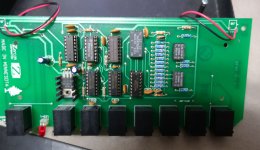I've got one of these 5250-to-USB converters, some clone 5250 adapters and a compatible terminal. I've got twinax pigtails and cables which work, but also have some RJ-45 baluns and I was wondering if I could use a pair of baluns and an RJ-45 cable between them instead of a twinax cable like this:
or can the baluns can only be used with a hub?
https://www.twindata.com/technical/whatisabalun.htm says this amongst other things:
The manual I got with the adapters says "Never connect two baluns to one Y-Cable", but can I have two RJ-45 cables in one twinax "network" (not sure what the correct term is there) so long as they're not both attached to the same pigtail, or is that "using in a series"? i.e. could I do the following?
Regarding pin-outs, all the baluns I have say they use pins 4 and 5, and the above says they have to match at both ends, so I assume I can use those with a straight-through RJ-45 cable?
I realise the page I linked to seems to confirm some of these things, but I'm not sure if what I'm doing is what "normal" users of these things do!
I also have some twinax inline surge protectors. Would there be any drawbacks to using them? There shouldn't be too much risk of a surge in my setup but I do like the idea of doing a little something extra to try to keep my terminal alive for a bit longer
Code:
terminal 5250 adapter 5250 adapter
| | |
nothing -- pigtail -- twinax cable -- pigtail -- twinax cable -- pigtail -- balun -- RJ-45 cable -- balun -- converteror can the baluns can only be used with a hub?
https://www.twindata.com/technical/whatisabalun.htm says this amongst other things:
The "at both ends" part makes me think I can have them at both ends of an RJ-45 run.
- Balun pin-out must match at both ends.
- Never daisy-chain baluns.
- Never use in a series.
The manual I got with the adapters says "Never connect two baluns to one Y-Cable", but can I have two RJ-45 cables in one twinax "network" (not sure what the correct term is there) so long as they're not both attached to the same pigtail, or is that "using in a series"? i.e. could I do the following?
Code:
terminal 5250 adapter 5250 adapter
| | |
nothing -- pigtail -- balun -- RJ-45 cable -- balun -- pigtail -- twinax cable -- pigtail -- balun -- RJ-45 cable -- balun -- converterRegarding pin-outs, all the baluns I have say they use pins 4 and 5, and the above says they have to match at both ends, so I assume I can use those with a straight-through RJ-45 cable?
I realise the page I linked to seems to confirm some of these things, but I'm not sure if what I'm doing is what "normal" users of these things do!
I also have some twinax inline surge protectors. Would there be any drawbacks to using them? There shouldn't be too much risk of a surge in my setup but I do like the idea of doing a little something extra to try to keep my terminal alive for a bit longer



